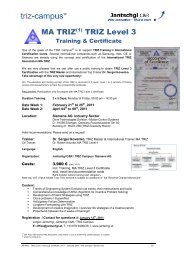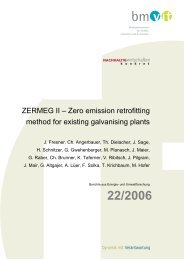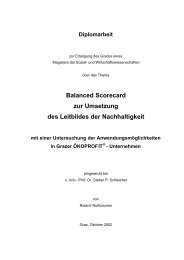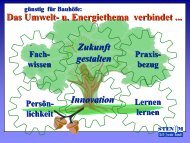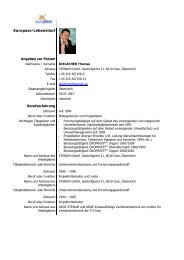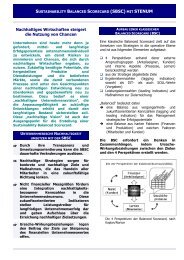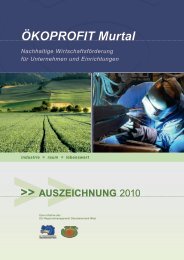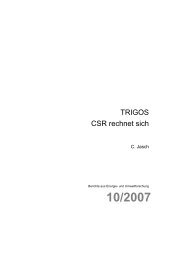Promoting Resource Efficiency in Small & Medium size ... - UNEP
Promoting Resource Efficiency in Small & Medium size ... - UNEP
Promoting Resource Efficiency in Small & Medium size ... - UNEP
You also want an ePaper? Increase the reach of your titles
YUMPU automatically turns print PDFs into web optimized ePapers that Google loves.
Quick W<strong>in</strong> Map<br />
Step 1:<br />
Identify Substances<br />
Step 2:<br />
Determ<strong>in</strong>e Hazardous Substances<br />
Step 3:<br />
Draw a Flowchart<br />
Step 4:<br />
Identify Risks<br />
Step 5:<br />
Consider Options<br />
Step 6:<br />
Evaluate Option and Implement<br />
Programme<br />
Steps Expla<strong>in</strong>ed<br />
Identify all substances used <strong>in</strong> the work<br />
area, their sources and transportation too<br />
and from the plant<br />
Determ<strong>in</strong>e if substances are hazardous<br />
with labell<strong>in</strong>g and MSDS<br />
Basic Reference (<strong>in</strong>cluded <strong>in</strong> the<br />
electronic version of the toolkit)<br />
Advanced Reference<br />
(<strong>in</strong>cluded <strong>in</strong> the electronic version<br />
of the toolkit)<br />
Identify substances • Hazardous Materials Worksheet<br />
Hazardous substances • Hazardous Materials Worksheet<br />
• Checklist hazardous materials<br />
Create a chemical flowchart Flowchart • Use the flowchart<strong>in</strong>g programme to<br />
create a chemicals flowchart<br />
Identity health, environmental, social and<br />
economic risks<br />
Consider options from literature,<br />
other <strong>in</strong>dustries’ experiences and/or<br />
recommendations from RE, CP and SP<br />
service providers. Undergo bra<strong>in</strong>storm<strong>in</strong>g<br />
session with your team<br />
Evaluate option, compile and implement<br />
programme (l<strong>in</strong>k to PDCA)<br />
Identify risks • Hazard Classification and Control<br />
Band<strong>in</strong>g<br />
Consider options • Further detailed process and<br />
sector related options, see Virtual<br />
Assessment<br />
L<strong>in</strong>k to DO-phase • Compile a programme and return to<br />
the PDCA cycle<br />
Table 19: Quick W<strong>in</strong> Map<br />
Where is this <strong>in</strong>formation found?<br />
• Purchas<strong>in</strong>g records<br />
• Stock control records<br />
• Inventories<br />
• Suppliers product <strong>in</strong>formation<br />
• Sales records<br />
• On the product label<br />
M<strong>in</strong>imum <strong>in</strong>formation to <strong>in</strong>clude <strong>in</strong> a Chemical Inventory:<br />
• The chemical name, trade name/Chemical Abstract numbers<br />
(CAS) number<br />
• Where it can be found, stored and/or used<br />
• Amount <strong>in</strong> use<br />
• R-Phrases/GHS classification<br />
• The whereabouts of MSDS (Material Safety Data Sheets) and<br />
their availability <strong>in</strong> the language of the workforce<br />
• Notes about handl<strong>in</strong>g, use, storage, disposal conditions, etc.<br />
• Whether the chemical is an <strong>in</strong>dividual substances or mixes<br />
(formulas)<br />
• Whether the chemical releases vapours <strong>in</strong> handl<strong>in</strong>g, mix<strong>in</strong>g or<br />
production<br />
• If the chemical is generated dur<strong>in</strong>g work activities (e.g. dust,<br />
fumes from weld<strong>in</strong>g)<br />
• Whether the chemical is used as an auxiliary (e.g. fats, liquors,<br />
dyes, pa<strong>in</strong>ts, adhesives)<br />
• Whether the chemical is used for purposes other than production,<br />
such as clean<strong>in</strong>g workplaces and ma<strong>in</strong>ta<strong>in</strong><strong>in</strong>g mach<strong>in</strong>ery (e.g.<br />
detergents, dis<strong>in</strong>fectants, solvents, greases, fuels)<br />
• Whether the chemical is found <strong>in</strong> the f<strong>in</strong>al product<br />
Step 2: Identify Hazardous Substances<br />
The follow<strong>in</strong>g sources can be used to obta<strong>in</strong> critical <strong>in</strong>formation on<br />
hazardous substances:<br />
• Safety data sheets of chemical substances<br />
• Labels attached to the chemicals packag<strong>in</strong>g<br />
• Technical manuals of the equipment<br />
• Legal regulations and technical standards<br />
• Scientific and technical literature<br />
• Records of work accidents and occupational diseases<br />
• Interviews with workers<br />
Importance of Material Safety Data Sheets (MSDS)<br />
An MSDS of a chemical substance conta<strong>in</strong>s details of the hazards<br />
associated with this specific substance and gives <strong>in</strong>formation on<br />
its safe use. Your chemical supplier should always <strong>in</strong>clude this<br />
<strong>in</strong>formation when deliver<strong>in</strong>g the chemical.<br />
An MSDS:<br />
• Helps you determ<strong>in</strong>e the effect of the chemical on end products (e.g.<br />
<strong>in</strong>tended characteristics, quality, etc.)<br />
• Allows you to determ<strong>in</strong>e chemical compatibility and do proper<br />
mix<strong>in</strong>g<br />
• Gives <strong>in</strong>formation about proper storage and handl<strong>in</strong>g (e.g.<br />
ventilation)<br />
• Enables you to prevent losses from the expiry of materials<br />
• Indicates appropriate security precautions and needed controls,<br />
<strong>in</strong>clud<strong>in</strong>g the use of personal protection equipment<br />
• Spells out emergency procedures <strong>in</strong> case of spills, fire and explosion<br />
• Indicates steps for first-aid<br />
• Specifies the hazard level, which gives clues about the possible<br />
effects on water, soil, human health<br />
• Specifies the flashpo<strong>in</strong>t (the lowest temperature at which a<br />
chemical releases flammable vapour); the lower the flashpo<strong>in</strong>t,<br />
the more hazardous the chemical is as a source of fuel for fire or<br />
explosion<br />
• Specifies the boil<strong>in</strong>g po<strong>in</strong>t, which is used to determ<strong>in</strong>e volatility; the<br />
lower the boil<strong>in</strong>g po<strong>in</strong>t, the higher the volatility 89<br />
International Chemical Safety Cards <strong>in</strong> different languages are available<br />
from www.cdc.gov/niosh/ipcs/icstart.html <strong>in</strong>dexed by their CAS. They can<br />
provide an orientation about chemicals, properties, and appropriate safety<br />
measures <strong>in</strong> case <strong>in</strong>formation on products is lack<strong>in</strong>g.<br />
Labell<strong>in</strong>g:<br />
To harmonize communication on hazardous chemicals and facilitate global<br />
trade, the United Nations, the International Labour Organization (ILO),<br />
89) GTZ, Chemical Management Guide for <strong>Small</strong> and <strong>Medium</strong> Sized Enterprises: Improve Chemical Management to Ga<strong>in</strong> Cost Sav<strong>in</strong>gs, Reduce Hazards and Improve Safety, 2006<br />
78



